AAC Assessment Corner with Vicki Clarke: AAC Assessment for Emergent Communicators
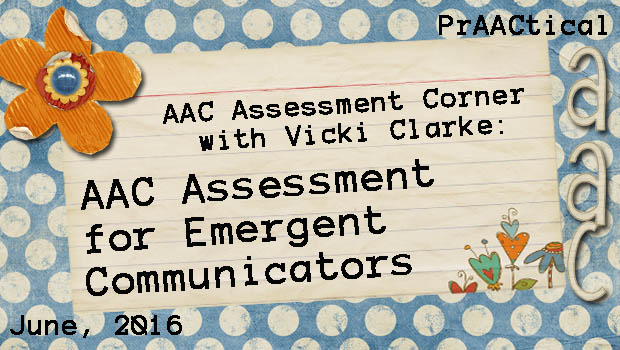
Today, we welcome back Vicki Clarke with more helpful information on conducting AAC assessments. If you work with individual who are at the early stages of communicative development, this post is for you!
::::::::::::::::::::::::::::::::::::::::::::::::::::::::::
Some of my most favorite students are those who, at first, may not seem to notice me at all. Sometimes these students seem to exist in their own worlds. They don’t seem to respond in ways we would expect: looking, attending, listening, or gesturing. They may have a diagnosis of Autism, significant developmental delay, epilepsy, or any number of syndromes.
I love these kids, and unfortunately, these are often the students who don’t get referred to me. Sometimes it takes years of working in a district before I get to see students with significant developmental delays. These children are typically served in classrooms for students considered to be severe/profound or multi-handicapped. Honestly, I usually get the chance to see these students when another student in their classroom (or nearby classroom) is referred and I happen to catch a peek at one of my friends. Being the delightful (and utterly not pushy) professional that I am, I often invite myself to be referred to help these favorite students of mine.
I think there are any number of reasons that these students are not referred for AAC including a misunderstanding that AAC is more than giving a child a high tech communication device. Professionals continue to labor under the false notion that there are prerequisites to AAC and that their students are not “ready” for AAC. Perhaps they see us as the “device ladies” who prescribe high tech systems and don’t have the right tools to help their more challenging students. The most alarming reason I was given for delayed referral was because the referring professional was concerned about wasting the district funds on assessing “such a low-functioning child.” Initial interaction with teams for children with significant needs has to be carefully orchestrated to educate the team, provide solutions that are impactful and realistic and, simultaneously respect the techniques that are already in place. Encouragingly, once we gain access to these classrooms, we are often invited back and enjoy lengthy, productive relationships with the very caring, engaged teams working there. I find watching these students “awaken” as their partners learn to recognizentheir communication attempts and reinforce them. We see students engagement increasing and their communication skills markedly improve.
So! What are the important features of assessment for children with significant communication impairment?
There are few challenges when starting with students with significant communication impairment. Most of the time, they have not had a comprehensive communication/language evaluation, so we have to start there. They cannot participate in standardized testing so therapists and teachers find themselves challenged to say more than that the student received a standard score of “less than 55.” Tests designed for verbal communicators who have functional sensory systems typically indicate that our children are profoundly impaired, at best, and at worst, compare their skills to infants. Neither of these measurements are helpful in determining an appropriate route to developing communication, so we have to look at more observational assessment tools.
I have three “go to” tools I use to evaluate students with significant needs, The Communication Matrix, Every Move Counts 3: Sensory Assessment, and Communication Sampling and Analysis. These tools give us information about how the student currently communicates and what motivates them to do so.
Assessing Motivations:
Very often professionals and parents have a difficult time pinpointing motivators for our students. There may be one toy or one favorite food item but often that’s about it. Every Move Counts 3: Sensory Assessment is a perfect solution to identifying potential motivators. The assessment involves systematic presentation of sensory experiences/objects and a precise, observational measurement of the student’s response, using a rating scale of 0-2 (basically, 0= no response, 1= awareness and 2= deliberate response). Multiple items/experiences are offered for each sense including visual, auditory, tactile, proprioceptive, vestibular and gustatory. The most challenging part of the assessment is gathering and transporting all the materials. When we started, we took a trip to Walmart, purchased a tool box and 4 divided boxes and loaded them with weird smelling, looking and feeling items. I wrote a blog post awhile back with lists of the items we collected that you can access here. Here’s what our initial kit looked like.
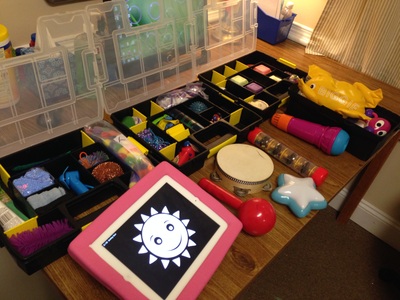
I just took this kit out to a classroom, in a district I serve, to assess several students with multiple developmental differences. I met children with cerebral palsy, epilepsy, CHARGE syndrome, cortical visual impairment and deaf-blindness. I played with each child for 20-30 minutes, presenting at least 3 experiences for each sensory type. When I finished, I had an individual profile of sensory preferences for each student. This is important because it gives me items to present to students that I know will be motivating enough to encourage them to communicate. It also gives me an idea of the type of sensory input they enjoy so that I can find new activities/items to expand their repertoire of leisure activities.
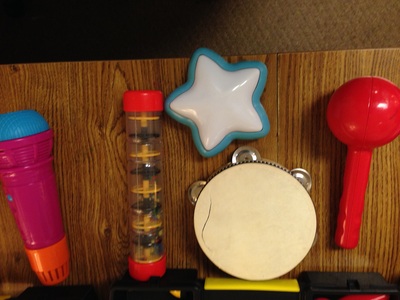
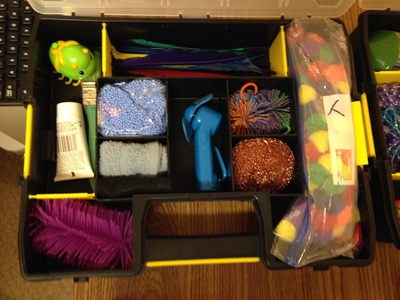 During the administration of EMC3 Sensory Assessment, I also watch to see how the student uses his body, voice and orientation to request recurrence, reject, and comment. The on-site teachers and therapists report that observing this evaluation is very enlightening for them as well. Often it is one of the few times that they can simply observe their student and process how the child is communicating. Most of the time we have very engaging team conversations after this experience. I often find it is a catalyst for the team to expand the types of activities they offer the children and, to improve their recognition of the naturally occurring communication that is already being used by the child.
During the administration of EMC3 Sensory Assessment, I also watch to see how the student uses his body, voice and orientation to request recurrence, reject, and comment. The on-site teachers and therapists report that observing this evaluation is very enlightening for them as well. Often it is one of the few times that they can simply observe their student and process how the child is communicating. Most of the time we have very engaging team conversations after this experience. I often find it is a catalyst for the team to expand the types of activities they offer the children and, to improve their recognition of the naturally occurring communication that is already being used by the child.
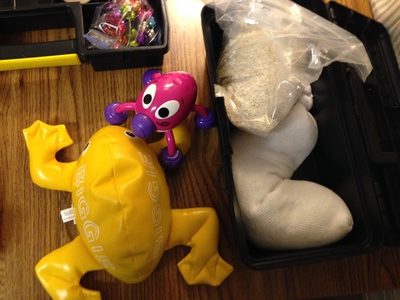
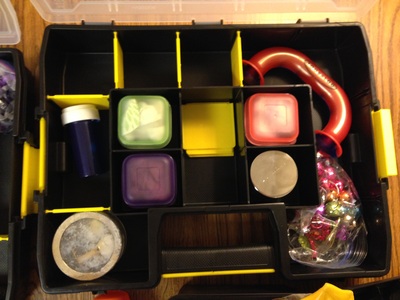
Current Communication Techniques: Communication Sampling and Analysis and Communication Matrix
We also want to know the methods and functions of communication the student is using in his typical daily interactions. I like to do this through parent/teacher interview and observation using The Communication Matrix, an online tools with a series of partner questions designed to identify the methods a child is using to communicate and the functions of that communication. It is designed to assess students from a pre-intentional level of communication up to intentional, symbolic and early generative language (pairing 2 symbols to communicate). It allows us to credit students with looking, quieting, reaching, touching, speaking and using symbols. The Matrix is one of the best tools I use to allow us to show specific strengths and needs in communication for very emergent communicators. Another handy perk, you can save your results for each student for repeated administrations you can compare over time. For a very nominal fee, you can also access a report generated from your results.
This year I started to look for an objective measurement of emergent language skills and came across Communication Sampling and Analysis,  an online communication sample analysis program that takes your sample of 25 communication exchanges and analyses it to determine the methods the child currently uses to communicate (including for example, gestures, facial expression, proximity and AAC). The program analyses the functions of communication including protesting, requesting, social exchanges and commenting. When you’re all done, you have percentages of different modes and functions of communication. Initially, this program took a little time to get used to coding the communication exchanges for mode and function but the results are worth the effort.
an online communication sample analysis program that takes your sample of 25 communication exchanges and analyses it to determine the methods the child currently uses to communicate (including for example, gestures, facial expression, proximity and AAC). The program analyses the functions of communication including protesting, requesting, social exchanges and commenting. When you’re all done, you have percentages of different modes and functions of communication. Initially, this program took a little time to get used to coding the communication exchanges for mode and function but the results are worth the effort.
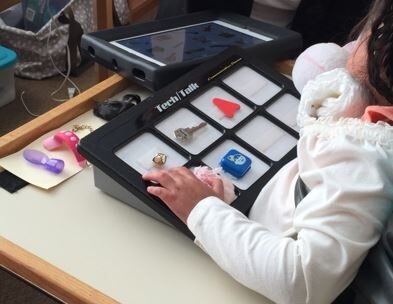 Once we have a baseline for how a student communicates, the solutions can be simple, we just consider the child’s current communication techniques and establish targets moving them along the continuum (from the Matrix); expanding their repertoire of modes and functions to include symbolic communication as soon as they are ready.
Once we have a baseline for how a student communicates, the solutions can be simple, we just consider the child’s current communication techniques and establish targets moving them along the continuum (from the Matrix); expanding their repertoire of modes and functions to include symbolic communication as soon as they are ready.
AAC solutions for these students are widely variable, as you would assume, given the variability of these children’s strengths and needs. Some solutions we have come up with for students going through this assessment have included partner input via co-active signing, object symbol schedules, tactile object mid-tech device trials, auditory scanning trials on high tech devices, PODD books and high tech dynamic display trials. These are children who, like all of us, are unique, with their own strengths and challenges. Discovering effective strategies to increase their communication can be a bit of a puzzle which is highly dependent on understanding their current communication and sensory skills, and their motivations. When you take time up front to assess these factors, the solutions often present themselves!
What are your favorite tools for evaluating students who are emergent communicators?
Filed under: Featured Posts, PrAACtical Thinking
Tagged With: assessment, beginning communicator
This post was written by Carole Zangari

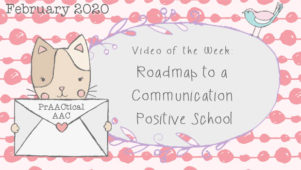
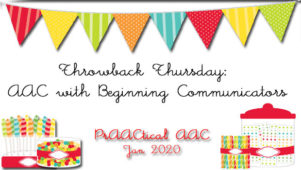
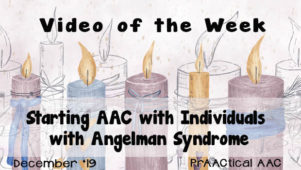
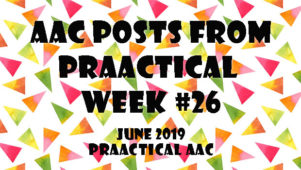
3 Comments
Good day!
Made device for reading human thoughts / human mind reading machine / Brain Computer Interface. In particular, I have created a perfect Speech Generating Device for people with Locked – in Syndrome ( LiS ) and ALS ( such as British physicist Stephen Hawking or Steve Gleason problem ). Discovery is not published. I invite partnership. About the problem look : Jack Gallant; Tom Mitchell and Marcel Just; John – Dylan Haynes; Andrea Stocco and Rajesh Rao, human mind reading machine .
Thank you. Syren Akopov. Russia
I also think it is really important to video record an interaction betweeen yourself and the person with a disability. Through your sensitive attuning, explore what the person responds too, how they respond, where they attend, when they express no, what might generate a smile, or a signal of anticipation. I think then doing a “langauge sample/script” of the interaction using photos can illustrate the interpretive nature of the conversation that is occur perhaps without words.
please use s2c instead